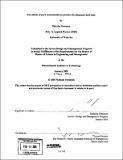The effects of part commonality on product development lead time
Author(s)
Svensson, Nicholas, 1965-
DownloadFull printable version (13.42Mb)
Other Contributors
System Design and Management Program.
Advisor
Thomas Roemer.
Terms of use
Metadata
Show full item recordAbstract
Nortel Networks, a leading global supplier of telecommunications equipment, is engaged in an increasingly competitive global market place. Within this market, Nortel Networks is positioning itself as the leader of global network transformation. The vision of the new transformed network is one in which disparate network elements are converged onto single architectural platforms serving the Client, Wireless Access, Network Services, Multi-services Packet, VoIP, Multi-services Optical and Element Management aspects of the newly transformed network architecture. This paper focuses specifically on the hardware development process associated with the CDMA wireless access element referred to as a base transceiver station (BTS) in the transformed network. The effect of part commonality on product development lead times are investigated at four levels of integration: common part (ASIC), common assembly (circuit pack), common field replaceable unit (module) and finally the common platform (BTS). At increasing levels of integration, the use of common parts leads to longer product development lead times. This observation is examined using two methodologies. The first methodology utilizes the three lenses framework focusing primarily on the impacts of organizational structure on the product development process. An evaluation of the existing barriers preventing joint gains and acceptable compromises to be achieved amongst share holders in joint development programs is discussed. Methods by which to minimize the impact of organizational structure on common product development lead time are given and comparisons are made with alternate organizational models from within the telecommunications industry. The second methodology employed utilizes task (cont.) design structure matrices (DSM) to analyze the implication of part commonality on product development lead times for projects structured in accordance with the Nortel Networks Life Cycle Management model. Effects modeled include stochastic durations, probabilistic iterations, learning effects, resource constraints, parallel tasks and overlapping tasks. An evaluation of the results indicates an increased sensitivity to extended product development lead times associated with probabilistic iterations. This is shown to be particularly evident during the requirements definition phase in which multiple stakeholder requirements must be captured comprehensively. This sensitivity is amplified by the fact that product verification takes place in multiple labs each exercising the equipment in unique and un-accounted for configurations. Based on the above analysis, a framework to ascertain the optimum level of commonality to pursue on a given product is given.
Description
Thesis (S.M.)--Massachusetts Institute of Technology, System Design & Management Program, 2005. Includes bibliographical references (p. 131-132).
Date issued
2005Department
System Design and Management Program.Publisher
Massachusetts Institute of Technology
Keywords
System Design and Management Program.